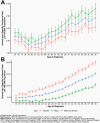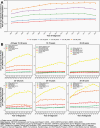CBTRUS Statistical Report: American Brain Tumor Association & NCI Neuro-Oncology Branch Adolescent and Young Adult Primary Brain and Other Central Nervous System Tumors Diagnosed in the United States in 2016-2020
- PMID: 38709657
- PMCID: PMC11073545
- DOI: 10.1093/neuonc/noae047
CBTRUS Statistical Report: American Brain Tumor Association & NCI Neuro-Oncology Branch Adolescent and Young Adult Primary Brain and Other Central Nervous System Tumors Diagnosed in the United States in 2016-2020
Abstract
Recent analyses have shown that, whereas cancer survival overall has been improving, it has not improved for adolescents and young adults ages 15-39 years (AYA). The clinical care of AYA with primary brain and other central nervous system (CNS) tumors (BT) is complicated by the fact that the histopathologies of such tumors in AYA differ from their histopathologies in either children (ages 0-14 years) or older adults (ages 40+ years). The present report, as an update to a 2016 publication from the Central Brain Tumor Registry of the United States and the American Brain Tumor Association, provides in-depth analyses of the epidemiology of primary BT in AYA in the United States and is the first to provide biomolecular marker-specific statistics and prevalence by histopathology for both primary malignant and non-malignant BT in AYA. Between 2016 and 2020, the annual average age-specific incidence rate (AASIR) of primary malignant and non-malignant BT in AYA was 12.00 per 100,000 population, an average of 12,848 newly diagnosed cases per year. During the same period, an average of 1,018 AYA deaths per year were caused by primary malignant BT, representing an annual average age-specific mortality rate of 0.96 per 100,000 population. When primary BT were categorized by histopathology, pituitary tumors were the most common (36.6%), with an AASIR of 4.34 per 100,000 population. Total incidence increased with age overall; when stratified by sex, the incidence was higher in females than males at all ages. Incidence rates for all primary BT combined and for non-malignant tumors only were highest for non-Hispanic American Indian/Alaska Native individuals, whereas malignant tumors were more frequent in non-Hispanic White individuals, compared with other racial/ethnic groups. On the basis of histopathology, the most common molecularly defined tumor was diffuse glioma (an AASIR of 1.51 per 100,000). Primary malignant BT are the second most common cause of cancer death in the AYA population. Incidence rates of primary BT overall, as well as specific histopathologies, vary significantly by age. Accordingly, an accurate statistical assessment of primary BT in the AYA population is vital for better understanding the impact of these tumors on the US population and to serve as a reference for afflicted individuals, for researchers investigating new therapies, and for clinicians treating these patients.
© The Author(s) 2024. Published by Oxford University Press on behalf of the Society for Neuro-Oncology. All rights reserved. For permissions, please e-mail: journals.permissions@oup.com.
Figures





















References
-
- Howlader N, Noone A, Krapcho M, et al.SEER Cancer Statistics Review, 1975-2012, National Cancer Institute. Bethesda, MD, http://seer.cancer.gov/csr/1975_2012/, based on November 2014 SEER data submission, posted to the SEER web site, April 2015. 2015.
-
- Bleyer A, Barr R, Hayes-Lattin B, et al.The distinctive biology of cancer in adolescents and young adults. Nat. Rev. Cancer. 2008; 8(4):288-298. - PubMed
Publication types
MeSH terms
Grants and funding
LinkOut - more resources
Full Text Sources
Medical

